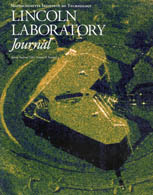Publications
Volume 8, Number 1
 |
|
Laser Vibration Sensing Laser vibration sensing has traditionally relied on limiters and frequency-modulation (FM) discriminators to process frequency-modulated laser radar returns. The performance of the traditional FM-discriminator approach can be limited by laser signature characteristics; both the temporal coherence of the laser and target speckle can degrade the performance of an FM-discriminator-based laser vibration sensor. We investigate a spectrogram-based frequency-demodulation technique that outperforms the traditional FM discriminator in the presence of both target speckle and limited laser temporal coherence. We compare the spectrogram and FM-discriminator techniques and present both theoretical and computer-simulation results for a vibrating diffuse or glint target with simple or complex piston motion that gives rise to FM-modulated return signals with speckle fading. Processed laser radar measurement data are used to add credibility to the results. These data include vibration signatures of the Low-Power Atmospheric Compensation Experiment (LACE) satellite. Fourier-Space Image Restoration Computational restoration techniques are frequently applied to two-dimensional images when the propagation medium or noise in the sensing apparatus significantly corrupts the recorded image data. Deconvolution processes are among the oldest and best understood of these techniques, although nonlinear and iterative computational methods can provide superior performance when real-time data processing is not a requirement. For many practical problems, however, Fourier deconvolution is the method of choice, because acceptable results can usually be obtained with a minimum of computational effort. The correction of point-spread-function distortions induced by sparse-aperture receivers is an example of an application for which Fourier deconvolution is particularly well suited. Sparse-aperture optical telescopes are highly advantageous if the costs associated with the orbital deployment of a filled-aperture receiver are prohibitive. A telescope incorporating a sparse-aperture mirror could be compactly folded to make a small lightweight payload, which could be placed into orbit by a relatively inexpensive launch vehicle. Although the raw imagery produced by a sparse-aperture system would show significant distortions, near diffraction-limited images can be recovered by using appropriate data processing techniques. To motivate this investigation, we use a three-petal telescope structure having a 10% fill factor as a model to study the image reconstruction process and its sensitivity to sensor noise. A receiver of this type can produce images comparable to those generated by a filled aperture of the same diameter, provided that an average signal-to-noise ratio on the order of 100 can be maintained over the entire image. The results of this study are promising, and lend strong support to the feasibility of constructing inexpensive, lightweight surveillance satellites employing folded-mirror architectures. Effects of Polarization and Resolution on the Performance of a SAR Automatic Target Recognition System Lincoln Laboratory is investigating the use of high-resolution fully polarimetric synthetic-aperture radar (SAR) imagery to detect and classify stationary ground targets. This article summarizes a study in which data collected by the Lincoln Laboratory 33-GHz SAR were used to perform a comprehensive comparison of automatic target recognition (ATR) performance for several combinations of polarization and resolution. The Lincoln Laboratory baseline ATR algorithm suite was used, and it was optimized for each polarization/resolution case. The polarizations evaluated were HH and PWF; the resolutions evaluated were 1 ft X 1 ft and 1 m X 1 m. The data set used for this study contained approximately 74 km2 of clutter (56 km2 of mixed clutter and 18 km2 of highly cultural clutter) and 136 tactical target images divided equally between tanks and howitzers. |
|